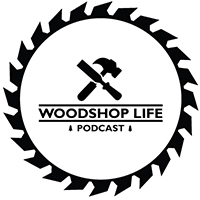Support us on Patreon: https://www.patreon.com/woodshoplife
Guy
1) Hey guys. Question on horsepower for table saws. I’m slowly moving toward upgrading my table saw (I won’t mention the brand so Guy won’t have a reason to make fun of me but let’s just say I’m looking forward to not dying). I currently have a 1.5 hp older delta contractor saw. My question to you is what hp are your saws and if there is a major difference between 1.5 and 3 hp? I don’t work with a ton of 8/4 or bigger stock so I wouldn’t be putting thick stuff through. Thanks for any insight! Ben
2) First off just wanted to say I love the show! You are all talented and experienced woodworkers but all offer different viewpoints on how you like to get things done.
My question is about table saw upgrades. I’ve had a Ridgid R4512 table saw for about 2 years now. I enjoy it but I’m wondering about upgrades. I’m specifically thinking about dust collection and the fence. I know I want to get a zero clearance fence but also wondering about over arm dust collection? Would it be worth it for this saw? Any aftermarket over arm set ups you guys would recommend or have experience with? The other upgrade I’ve considered is a fence. I’ve found that at times I feel the fence on this saw might be a little inaccurate and it doesn’t have a lot of adjustments. Do you feel any of the aftermarket fence systems would be good for this saw? Any recommendations? Or would you recommend possibly saving money to just get a better saw in the future if you felt like the upgrades weren’t worth making to this saw.
Thanks for the time. Again, love the show.
Brian Bingham
Sean
1) I’ve seen a few people online build jointer sleds to edge joint and flatten boards. Can I actually get decent results out of a jointer sled in most cases? I assume using a jointer sled for processing a large amount of lumber would be a hassle compared to using a floor standing jointer, but what are the other limitations to using a jointer sled that I am not considering? Brock
2)
Still loving the show. I wrote in once before and you sold me on shellac finish for small boxes, and you made me a believer.
I do have a new question,
I’m building a dresser for my daughter and I’m not sure how to finish the job. The main carcass and drawers are mostly plywood with oak edge banding. I made the base out of oak and the drawer fronts will also be oak which I plan to stain to let the grain show through.
Do you guys normally finish the inside of the drawers in a dresser? If so, what do you use?
Also, I was going to paint the carcass(it’s plywood, don’t freak out), so I’m wondering if you have any tips on how to get that perfect painted finish on the carcass? I don’t have a sprayer, and the budget is tight, so I won’t be buying a fuji anytime soon, but any other tips are much appreciated!
Thanks, Scott
Huy
1) Love the podcast. Thanks for everything that you put into it. I recently resawed some 5/4 walnut, about 32″ long, for some drawer faces (shop furniture). My plan was to resaw this and then glue up a panel to have continuous grain down the three drawers. The walnut had been in my shop for a few months and I got it from a reliable source, so I was pretty comfortable with the moisture, although I don’t have a moisture meter. I had milled a face and an edge square, but as I was resawing it, the two pieces bowed significantly, to the point that they would require another round of milling, and getting 3/8″ to 1/2″ final thickness was not possible. Did I do something wrong, or is that to be expected when resawing something to that thickness? Chad
2) I am using a 3/8″ diameter upcut spiral bit with a 1/2″ diameter shank from Whiteside to make 1 1/8″ deep mortises in some cherry. Whiteside says the bit is good for 1 1/4″ deep. I am using the bit in the Porter Cable 690LR fixed base router. My questions: How deep a cut is recommended per pass? Is there any criteria out there for depth of cut?
Dave
